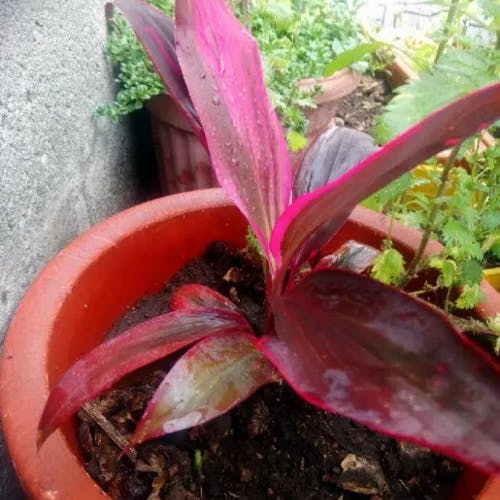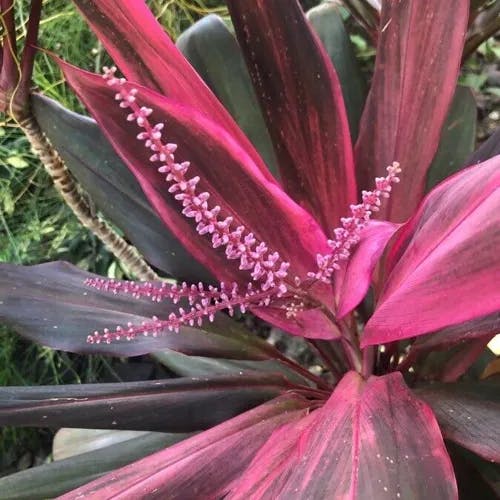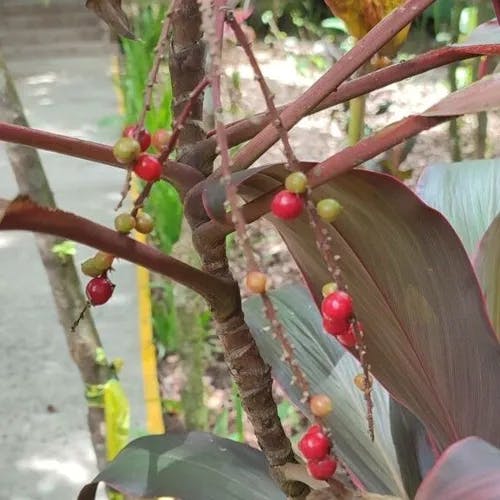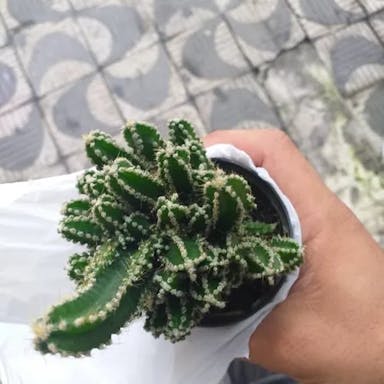The vibrant and diverse plant Cordyline fruticosa has numerous names including Palm Lily of the broadleaf variety in the scientific community. This evergreen plant of the Asparagaceae family requires partial shade and rich drainage. It is commonly referred to as the ti or good fortune plant and is considered a sign of prosperity in Hawaiian culture. The leaves of the Cordyline fruticosa can reach up to 1.5 meters and exhibit an array of hues like red, pink, purple and green combinations. Though it generates tiny white or pale pink blooms, this plant is prized for its ornamental and glossy foliage. The tropical looking leaves add charm to gardens and indoor areas where it is simple to grow. While it can tolerate sunlight or shade, it thrives with partial sun exposure. The Cordyline fruticosa is often used in landscaping and as a houseplant thanks to its decorative leaves and straightforward maintenance. Additionally, its leaves may be utilized for hula skirts and weaving in traditional Hawaiian ceremonies thought to carry positive energy.
Ti Plant
- Common name
- Hawaiian Ti Plant
- Scientific name
- Cordyline fruticosa
Basic Information
- Asparagaceae Family Cordyline Genus Ti Plant Species
- Asparagaceae > Cordyline > Cordyline fruticosa
- 83%
- The Completeness of This Encyclopedia
Please help us complete the encyclopedia, Terrarium is a encyclopedia service to be completed with everyone in the world. Currently, this page is 83% complete. For more information on how to contribute, please click here.
- Perennial
- Shrub
- Height
- 300cm ~
- Flower Color
- Leaf Color
- Anthesis
- spring, summer
- Sunlight Exposure
Full Sun Long hours of sunlight from morning to afternoon Partial Shade A location in the shade of a tree or where either the morning or afternoon is shaded Full Shade A place where there is no direct sunlight
- Full Sun
- Hardiness Zones
This is an indicator to know to which zone each plant can winter. Knowing the zone of each plant gives you an idea of the cold temperature resistance when grown in the ground without a roof. 2: -42.7 to -40.0 3: -39.9 to -34.4 4: -34.3 to -28.9 5: -28.8 to -23.3 6: -23.2 to -17.8 7: -17.7 to -12.2 8: -12.1 to -6.7 9: -6.6 to -1.1 10: -1.0 to 4.4 11: 4.5 to 10.0
- 10
- Cold resistance
- Poor
- Heat resistance
- Excellent
- Habitat of origin
- Australia, New Zealand, Papua New Guinea
- Growth Rate
- Normal
What is Ti Plant (Cordyline fruticosa)?
What is Ti Plant (Cordyline fruticosa)
Flower meaning
The symbolic meaning usually related with the Broadleaf palm-lily across the United States expresses veneration and gratefulness. This vegetation represents esteem for accomplishment, strength, elegance, and flexibility. It voices tribute without connection to exact birthday. Though floral languages differ between cultures, the palm-lily retains significance. Admiration's flower does not appoint months. Convey regard through Broadleaf palm-lily. Its leaves symbolize admiration's notion. Focus bloom implications on era, nation, and customs. Do not generalize plant emblems. Consider culture and situation upon translating meaning. Palm species shows respect and acclamation. Tender petals represent triumph and power. Flexible branches display surviving storms. Distinguished greenery conveys reverence.
Calendar of Ti Plant (Cordyline fruticosa)
Calendar
The plant with the botanical designation Cordyline australis, native to New Zealand, is extensively planted as an ornamental in the USA. The season when it blossoms is contingent on climate and cultivation conditions. It generally flowers during spring and summer. Peak blooming occurs in the middle of summer, commonly in July and August. Variables like ambient temperature, light exposure, and soil dampness influence the flowering time. Adequate sunlight and well-draining ground are imperative for ideal blooming. It usually takes several weeks for the blossoms to fully mature and open. In this time, the plant needs regular irrigation and feeding to support vigorous growth and blooming. To lengthen the blooming period, it is vital to appropriately care for and maintain the plant. This involves scheduled watering, fertilizing with a balanced fertilizer, and removing spent or faded blooms. Moreover, shielding the plant from temperature extremes and providing sufficient shade in hot summer days can assist prolonging the blooming duration. On the whole, the plant with the common name Broadleaf palm-lily adds a touch of tropical elegance to gardens and landscapes across the USA.
How to grow Ti Plant (Cordyline fruticosa)
Watering
The schedule of hydrating regarding the Broadleaf palm-lily shrub depends upon numerous causes. As the thriving season approaches, which happens during spring and summertime, the greenery calls for constant moisturizing to sustain earth dampness. It is recommended to soak the shrub once every 7-10 days, making certain that the terrain is consistently moist however not waterlogged. The number of hydration required can differ contingent on the size of the shrub and the circumstantial criteria, however typically dispensing 1-2 inches of hydration per moistening meeting is adequate. Conversely, during the dormant period in fall and winter, the Broadleaf palm-lily needs less recurrent hydration. It is of import to permit the terrain to dry out somewhat between moistenings to hinder root decay. Hydrating once every 2-3 weeks is normally sufficient during this time period. To specify the ideal hydrating schedule, it is critical to monitor the terrain humidity regularly. This can be accomplished by embedding a digit or a dampness meter into the terrain to value its dampness elevation. Adapt the hydrating recurrence accordingly to sustain the ideal terrain dampness for the Broadleaf palm-lily flora. The shrub requires barely sufficient hydrating to survive dormancy but not adequate to simulate growth.
Soil and Fertilizer
After late fall, the palm plant will exist in a resting state. Gentle propagation of fertilizing elements during wintertime may cause damage to roots. A balanced mixture for thriving may be administered every month and a half during active development. Analysis of soil composition is important. Excessive quantities of minerals can produce unhealthy results. Appropriate moisture and mild sourness helps the plant. Palm plants require fertilizing components, drainage, and organic material in the ground. Specific proportions of nitrogen, phosphorus, and potassium support healthy plants. Spreading fertilizer carefully avoids harming leaves and stems. Growing happens during warmer periods and decreases when cold. Verifying pH and moisture aids the plant’s needs. Different amounts of fertilizer depends on conditions. Too much fertilizer when resting is problematic.
Sunlight and Place
The predilection bright temperature interval for this division is total fifteen degree celsius to five and twenty degree celsius. It flourishes in good but not utmost chill or burning provisions. In conditions of inflame allow, this organism claims a average quantity of visible radiation. It ought to obtain surround four to sestet hours of forthright or oblique sunlight per twenty-four hours. It can brave temperatures as inferior as negative decennium point celsius without major wrong. Though, lengthened display to gelidness may create scathe to the works leaves and stems. At the summer, it ought to be situated in a location that gets incomplete shadescreen to protect it from intensifying visible radiation. It likes radiant only indirect igniter. During season, it is principal to shelter it from gel by screening it. On the whole, it is an various flora that tin tolerate a reach of temperatures, merely thrives in mild to emotional stipulations with mean sunlight showing.
Advanced Information of Ti Plant (Cordyline fruticosa)
Pruning
The cordyline australis plant demands regular trimming and cutting to preserve its fitness and show. Pruning is required to eliminate expired or impaired leaves, encourage novel maturation, and dictate the extent and form of the plant. The finest season to prune the cordyline australis is late frost or initial bounce before the maturation time starts. To prune the cordyline australis, initiate by excising any withered or yellowing leaves at the foundation of the plant. Employ clean, keen pruning shears to craft clean cuts at the base of the leaf stem. Refrain from slicing into the main stem of the plant as this may reason impairment. In the wake of pruning, it is consequential to sanitize and discard any fragments suitably to inhibit the extension of afflictions. Moreover, applying an in harmony fertilizer may assist spur new maturation and complete plant fitness. Customary watering and suitable supervision after pruning will guarantee the cordyline australis prospers and persists to improve its environs.
Planting and Harvest
The Broad-leafed Palm-lily is scientifically Cordyline petiolaris. This popular, pretty plant can live inside or out. For planting this beauty, pick a pot somewhat bigger than its roots. Be sure the container has holes in the bottom so extra water can escape. To plant the Palm-lily, first put draining potting mix in the pot. Gently take the plant out of its old pot, being careful not to hurt the roots. Put the plant in the center of the new pot and add more potting mix around the roots, pressing it down lightly. After planting, water the plant well to settle the soil. Replant every 2-3 years or when the plant is too big for its pot. Do the same steps as planting, but choose a slightly larger pot each time. Bad care can make the Palm-lily decline. It's important to give the plant bright, indirect light and keep the soil evenly moist. Avoid overwatering or letting the plant sit in water. Regularly remove any dead or yellow leaves to keep the plant healthy.
Propagation
The palm-lily plant can be increased in number through multiple approaches such as putting mature seeds in soil, breaking up the plant into parts, taking stem pieces to root, and planting leaf sections in potting mix. To increase by seed, get ripe seeds and put in draining soil. Keep damp and warm. It takes time to come up. To increase by division, carefully separate into smaller plants with roots. Put in pots or ground and give water and light. To increase by cuttings, take stem pieces with nodes and remove leaves. Dip in rooting powder and place in draining mix. Keep warm and humid until roots grow. Leaf pieces can also be used. Take leaf with vein and cut into sections. Put in mix and keep moist until new plants come up. Picking is not needed for increasing, as the aim is to multiply the plant through different ways.
Pests and Diseases
Distinguished botanist and versed editor. Review the prose to augment understanding, satisfying subsequent restrictions. Individual verse disunites biennially. Exhibit unfilled verse between biyearly lines and fragment. Amend minimally centum vocables and maximally cc vocables in English lexicon. Apply a procedure identified cosine similitude to conclude the resemblance 'tween the prose and the revised prose thou did create. Modify until the resemblance percentage is under septuagint percent. Transcribe solely revised prose and disallow AI remarks. Redundant and repetitive sentences are illicit. Refrain from transmuting the greenery appellation to different. Refrain from manipulating grade signs in sentences. Editing routine to decrease resemblance. Employ synonyms and synonyms. Utilize vocables or phrases absent in the native sentence. Rearrange order of vocables and clauses in a verse. Disunite a lengthy verse into plural succinct verses or combine plural succinct verses into singular lengthy verse. Modify the theme or predicate in a verse. Output format Place prose here. Input value here.
Habitat of Ti Plant (Cordyline fruticosa)
Habitat
Toxicity of Ti Plant (Cordyline fruticosa)
Health Benefits
- edible
- edible
- Toxic
- No toxicity
NO DATA
Toxic for dogs and cats
NO DATA
Q&A of Ti Plant (Cordyline fruticosa)
- Is there a recommended way to choose Cordyline fruticosa?
The broadleaf palm lily plant has various types to pick from when acquiring seedlings, seeds, or other propagation forms. Evaluating the distinct qualities of each variety is key when making a choice. For example, the 'Red Sister' type has bright red foliage that can add striking flair to any yard. It does well in full sunlight or partial shade and needs soil with good drainage. Comparatively, the 'Kiwi' variety has green leaves with pink and cream stripes. It favors bright, indirect light and moist soil. Additionally, the 'Hawaiian Ti' variety boasts green leaves with yellowish or white variegation. It can handle varying light and slightly acidic soil. When getting seedlings, choose healthy plants without disease or pest signs. The leaves should be vibrant without discoloration or damage. If purchasing seeds, make sure they are fresh and from a reputable provider. Follow the instructions for optimal germination and growth. By evaluating the specific traits of each variety and selecting healthy seedlings or seeds, you can enjoy the beauty of broadleaf palm lily in your garden.
0
0
- What Are the Characteristics of Broadleaf Palm Lily?
The tropical evergreen Broadleaf Palm Lily retains leaves throughout the year. Its tall woody stems reach 3 meters high. This plant's small fragrant pale lavender flowers produce red or yellow berries afterwards. Resiliently withstanding various conditions, it thrives in well-drained soil with partial to full sunlight exposure. Its vibrant broad leaves ranging green to purple characterize this Cordyline fruticosa scientifically.
0
0
- How to Care for Broadleaf Palm Lily Plants?
The flower-inducing succulent woodland vining plant identified as Cordyline fruticosa thrives when established in land with porous soil and sunlight. Supply moisture at regular intervals and permit the ground to become dry prior to subsequent irrigation to avert fungal growth of subterranean stems. Administer a balanced fertilizer of slow nutrient release during increasing sunlight for ideal maturation. Remove expired or impaired leaves to uphold aesthetic presentation and robustness. Finally, atmospheric moisture content is preferred by the flora, so simulate misting the verdure or situate an aqueous holder nearby.
0
0
- Can Oriental Lily Be Grown Indoors?
The Cordyline fruticosa plant has the common name Oriental Lily and can grow well inside a home. This plant can adapt and live in indoor places if it gets enough light and moisture in the air. You need to be careful not to put it in sunlight directly because that can hurt the leaves. Also, the Oriental Lily likes soil that drains well and you should water it regularly but not too much, or it could get root rot. If you take good care of it, this plant can make your indoor area look more tropical and beautiful.
0
0












